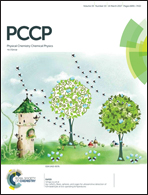Adsorption dynamics of molecular nitrogen at an Fe(111) surface
Abstract
We present an extensive theoretical study of N2 adsorption mechanisms on an Fe(111) surface. We combine the static analysis of a six-dimensional potential energy surface (6D-PES), based on ab initio density functional theory (DFT) calculations for the system, with quasi-classical trajectory (QCT) calculations to simulate the adsorption dynamics. There are four molecular adsorption states, usually called γ, δ, α, and ε, arising from our DFT calculations. We find that N2 adsorption in the γ-state is non-activated, while the threshold energy is associated with the entrance channel for the other three adsorption states. Our QCT calculations confirm that there are activated and nonactivated paths for the adsorption of N2 on the Fe(111) surface, which is in agreement with previous experimental investigations. Molecular dynamics at a surface temperature Ts = 300 K and impact energies Ei in the 0–5 eV range show the relative occupancy of the γ, δ, α, and ε states. The δ-state, however, is only marginally populated despite its adsorption energy being very similar to that of the γ-state. Our QCT calculations trace the dependence of molecular trapping on the surface temperature Ts and initial impact energy Ei and quantify the rates of the different competitive channels that eventually lead to molecular adsorption.



 Please wait while we load your content...
Please wait while we load your content...